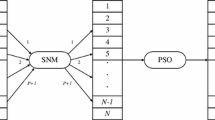Abstract
Training a neural network is a difficult optimization problem because of numerous local minima. Many global search algorithms have been used to train neural networks. However, local search algorithms are more efficient with computational resources, and therefore numerous random restarts with a local algorithm may be more effective than a global algorithm. This study uses Monte-Carlo simulations to determine the efficiency of a local search algorithm relative to nine stochastic global algorithms when using a neural network on function approximation problems. The computational requirements of the global algorithms are several times higher than the local algorithm and there is little gain in using the global algorithms to train neural networks. Since the global algorithms only marginally outperform the local algorithm in obtaining a lower local minimum and they require more computational resources, the results in this study indicate that with respect to the specific algorithms and function approximation problems studied, there is little evidence to show that a global algorithm should be used over a more traditional local optimization routine for training neural networks. Further, neural networks should not be estimated from a single set of starting values whether a global or local optimization method is used.
Similar content being viewed by others
References
Uryasev S, Pardalos PM (eds) (2001) Stochastic optimization: algorithms and applications. Kluwer Academic Publishers, Netherlands
Porto VW, Fogel DB, Fogel LJ (1995) Alternative neural network training models. IEEE Expert 16–22
Sexton RS, Dorsey RE and Johnson JD (1999). Beyond backpropagation: using simulated annealing for training neural networks. J End User Comput 11: 3–10
Ludermir TB (2003). Neural networks for odor recognition in artificial noses. Proceedings of the International Joint Conference on Neural Networks 1: 143–148
Mirmirani S and Li HC (2004). Gold price, neural networks and genetic algorithm. Comput Econ 23: 193–200
Matilla-Garcia M and Arguello C (2005). A hybrid approach based on neural networks and genetic algorithms to study the profitability in the Spanish stock market. Appl Econ Lett 12: 303–308
Zhao Z (2006). Steel columns under fire—A neural network-based strength model. Adv Eng Sof 32: 97–105
Binner JM, Graham K and Gazely A (2004). Co-evolving neural networks with evolutionary strategies. A new application to Divisia money. Adv Econom 19: 127–143
Fisher MM, Hlaváčková-Schindler K and Reismann M (1999). A global search procedure estimation in neural spatial interaction modeling. Pap Reg Sci 78: 119–34
Maniezzo V (1994). Genetic evolution of the topology and weight distribution of neural networks. IEEE T Neural Networ 5(1): 39–53
Plagianakos VP, Magoulas GD and Vrahatis MN (2001). Learning in multilayer perceptrons using global optimization strategies. Nonlinear Anal 47: 3431–3436
Georgieva A, Jordanov I (2006) Supervised neural network training with a hybrid global optimization technique. 2006 International Joint Conference on Neural Networks, Vancouver, BC, Canada, July
Ye H, Lin Z (2003) Global optimization of neural network weights using subenergy tunneling functions and ripple search. Circuits and Systems, 2003, Isacs ’03. Proceedings of the 2003 International Symposium on, vol. 5, Issue 25–28, May 2003, pp V-725–V-728
Michalewicz Z (1996) Genetic algorithms + data structures = evolution programs 3rd rev. and extended ed., Springer-Verlag, Berlin
Syswerda G (1991). Schedule optimization using genetic algorithms. In: Davis, L (eds) Handbook of genetic algorithms, pp 332–349. Van Nostrand Reinhold, New York
Davis L (ed) (1991) Handbook of genetic algorithms. Van Nostrand Reinhold, New York
Franses PH and van Dijk D (2000). Nonlinear time series models in empirical finance. Cambridge University Press, Cambridge
Hamm L and Brorsen BW (2000). Trading futures markets based on signals from a neural network. Appl Econ Lett 7: 137–140
Granger CW and Andersen AP (1978). An introduction to bilinear time series models. Vandenhoek and Ruprecht, Gottingen
Yang S-R and Brorsen BW (1995). Nonlinear dynamics of daily foreign exchange rates. Adv Quant Anal Finance Account 3: 111–130
Gallant A and White H (1992). On learning the derivatives of an unknown mapping with multilayer feedforward networks. Neural Networks 5: 129–138
Prechelt L (1994) Proben1—A set of neural network benchmark problems and benchmarking rules. Technical Report 21/94, Universitat Karlsrude. http://page.mi.fu-berlin.de/~prechelt/Biblio/1994-21.pdf
Pardalos PM, Romeijn E (eds) (2002) Handbook of global optimization vol 2: Heuristic approaches. Dordrecht, Netherlands
Boender CGE and Romeijn HE (1995). Stochastic methods. In: Horst, R and Pardalos, PM (eds) Handbook of global optimization, pp 829–869. Kluwer Academic Publishers, Netherlands
Skinner AJ and Broughton JQ (1995). Neural networks in computational materials science: training algorithms. model Simul Mater Sci 3: 371–390
Yan W, Zhu Z, Hu R (1997) A hybrid genetic/bp algorithm and its application for radar target classification. Proceedings of the 1997 IEEE National Aerospace and Electronics Conference (NAECON) 2:981–984
IMSL Math/Library version 3.0 (1997) Visual Numerics, Houston, TX
van Rooij AJF, Jain LC, Johnson RP (1996). Neural network training using genetic algorithms. World Scientific Publishing Co., Singapore
Schwefel HP (1995). Evolution and optimum seeking. Wiley, New York
Szu H and Hartley R (1987). Fast simulated annealing. Phys Lett A 122: 157–162
Solis FJ and Wets JB (1981). Minimization by random search techniques. Math Oper Res 6: 19–30
Baba N, Mogami Y, Kohzaki M, Shiraihi Y and Yoshida Y (1994). A hybrid algorithm for finding the global minimum of error function of neural networks and its applications. Neural Networks 7: 1253–1265
Author information
Authors and Affiliations
Corresponding author
Rights and permissions
About this article
Cite this article
Hamm, L., Brorsen, B.W. & Hagan, M.T. Comparison of Stochastic Global Optimization Methods to Estimate Neural Network Weights. Neural Process Lett 26, 145–158 (2007). https://doi.org/10.1007/s11063-007-9048-7
Received:
Accepted:
Published:
Issue Date:
DOI: https://doi.org/10.1007/s11063-007-9048-7




